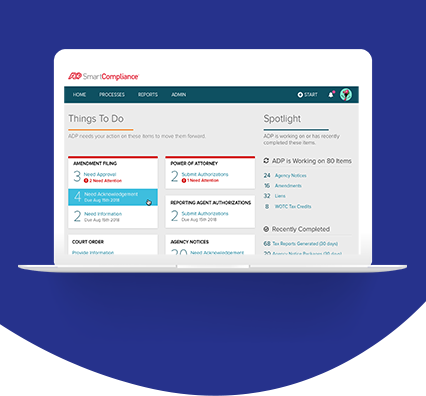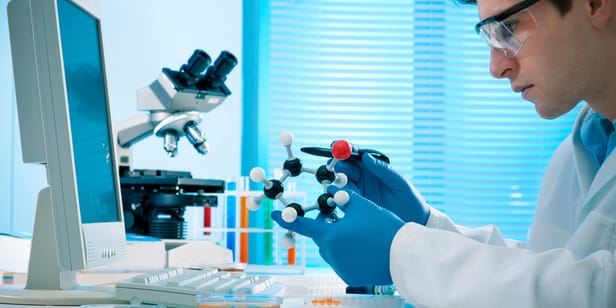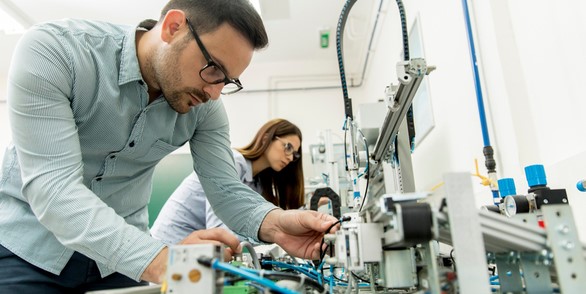More businesses than ever before may be eligible for the research and development (R&D) tax credit. Certified public accountants (CPAs) who thoroughly understand the qualifications for this opportunity can better help their clients maximize their return on investment, while maintaining compliance.
Research & development tax credit – IRS Section 41
Defined under Section 41 of the Internal Revenue Code, the federal R&D tax credit is a dollar-for-dollar reduction of a company’s tax bill, based on qualified domestic expenses related to the design, development or improvement of products, processes, techniques, formulas or software. The Protecting Americans from Tax Hikes (PATH) Act of 2015 (effective January 1, 2016) permanently extended the R&D tax credit and broadened the ability of many businesses, especially small-to-midsize organizations, to monetize it.
Who qualifies for the R&D credit?
Any company engaged in activities to develop or improve products, processes, software, formulas, techniques or inventions in a way that required some level of technical experimentation to determine the most accurate and appropriate design may qualify for the R&D credit. No industry or business type is excluded, although by the nature of their activities, someare more qualified than others.
What are qualified research and development activities?
Activities that may qualify for the R&D tax credit include, but are not limited to the development or improvement of:
- Products (tangible or intangible)
- Processes (manufacturing processes, technical processes, etc.)
- Software (intended for either external or internal use)
- Formulas
- Techniques
- Inventions (patentable activities)
Examples of qualified activities
Examples of qualified activities for the R&D tax credit may include, but are not limited to:
- Developing a product to market
- Improving existing product functionality, quality, reliability or performance
- Evaluating alternatives to existing products or processes
- Testing product prototypes
- Researching solutions intended to reduce time-to-market for a product
- Developing a manufacturing process to mass produce a product
- Improving an existing manufacturing process, in whole or in part, to increase automation, efficiency or throughput, or to reduce cost, waste, bottlenecks, etc.
- Developing or improving a technical process (engineering, drilling, etc.)
- Developing a software (application, mobile app, bridging functionality, etc.) to sell, lease or license to a customer
- Developing software to help facilitate a service or to bridge or interface between outside parties (B2B or B2C) or internally within multiple systems
- Developing and experimenting with formulations (chemical, food, livestock feed, etc.)
- Improving existing techniques (manufacturing, welding, drilling, coating, finishing, etc.)
- Developing something that is patentable
- Paying outside consultants to conduct any of the above activities
How to determine R&D eligibility?
Determining eligibility for the R&D tax credit is based upon qualifying criteria established by the IRS to ascertain whether a business expense results in product, process, software, technique, formula or invention improvements through the application of technology in a way that is inherently experimental in order to achieve the most accurate and appropriate design.
The IRS four-part test
The IRS applies the following four-part test to determine whether an expense qualifies for the R&D tax credit:
- Does it lead to the creation or improvement of a product, process or software? The activity must be related to developing or improving the functionality, quality, reliability or performance of a business component (i.e., product, process, software, technique, formula or invention).
- Is it technological in nature? The business component’s development must be based on hard science, such as engineering, physics or chemistry, or the life, biological or computer sciences.
- Was there uncertainty about the method, approach or outcome? The company must have faced technological uncertainty at the activity’s outset related to either the appropriate design of the business component or their capability or method of developing it.
- Was the process experimental in nature? The business must have evaluated multiple design alternatives or employed a systematic trial and error approach to overcome the technological uncertainties.
- Section A has eight lines of required information (Lines 1,2,3,7,8,10,11,17)
- Section B applies to the alternative simplified credit (ASC)
- Section C is used to identify additional forms and schedules that warrant reporting based on a business’s structure
- Section D is only required for qualified small businesses (QSBs) making a payroll tax election
- Identify and evaluate new opportunities for which they may be eligible
- Keep accurate records so they can make data-driven decisions
- Comply with changing tax credit laws and avoid penalties
- Report tax credit activities and meet deadlines
- Defend the credits under an IRS or state taxing authority audit
Documentation
Documentation requirements for the tax credit are broadly defined. Per the IRS tax code, taxpayers are simply required to “retain records in a sufficiently usable form and detail to substantiate that the expenditures claimed are eligible for the credit.” Examples may include employee Form W2s, payroll registers, time tracking data, orders/invoices/receipts for qualified supplies, technical design requirements, specs or schematics, prototype documents, test plans and results, etc.
What expenses qualify for the R&D tax credit?
Certain domestic labor, supplies, contracted services and cloud computing expenses related to the development and/or improvement of products, software or processes can qualify for the R&D tax credit.
Qualified labor
Labor performed for R&D expenditures that meet the four IRS qualifying criteria (and are not explicitly excluded) may be eligible for the R&D tax credit. This includes taxable wages for employees who are directly involved in technical design requirement definitions, technical spec development, prototyping or coding, testing, and redesign and retesting, as well as the individuals who directly supervise or support them.
Qualified supplies
Qualified supplies for the R&D tax credit include any raw materials or supplies used in research and development that were not capitalized or depreciated. This includes materials used to fabricate and test prototypes, or materials used during product or process design or testing. Expenditures for supplies that are indirectly related to R&D, including general and administrative costs, don’t qualify for the R&D tax credit.
Qualified contract research expenses
Qualified contract research expenses require qualifying businesses to bear the economic risk of the work performed by the contractor, regardless of whether it’s successful or not. Software development, engineering, prototype fabrication and research contract expenses are typical examples.
How does the R&D Tax credit’s “startup provision” work?
Startup businesses may qualify for an R&D tax credit up to $250,000 annually for up to five years, for a total of $1.25 million to offset the Federal Insurance Contributions Act (FICA) portion of their annual payroll taxes. The company must have less than $5 million in gross receipts for the credit year and no more than five years of gross receipts.
How do you calculate the R&D tax credit?
A percentage of current-year, qualified research activities above and beyond a base amount, calculated using prior-year efforts and investments, may qualify for R&D tax credit. Typically, 6% to 8% of a company’s annual eligible costs can be applied, dollar for dollar, against its federal income tax liability. Unused R&D credits due to lack of tax liability can be carried forward up to 20 years. Federal taxpayers can also claim the R&D credit retroactively by filing amended returns for open tax years, typically the past three tax years (or more if the company endured losses during that time).
What is the fixed-base percentage R&D tax credit?
A business’s R&D tax credit base is calculated using a fixed-base percentage. Qualified expenses and gross receipts from certain historical years determine the rate, which cannot exceed 16%. The fixed-base percentage is then multiplied by the average annual gross receipts for the prior four years to achieve the R&D tax credit base. This amount may not be less than half of the current-year qualified research expenses (QREs).
How do I claim the R&D tax credit?
Businesses can claim the R&D Tax Credit by filing IRS Form 6765. As part of the process, they need to determine which expenses qualify and maintain adequate documentation to substantiate R&D expenses. This generally includes financial records detailing expenses, business records or oral testimonies that identify which expenses were related to qualified activities, and technical documents that show how the qualified activities met the Section 41 requirements.
Form 6765 is composed of four basic sections (A, B, C, D) that must be completed to verify a company’s qualified research expenses:
Businesses can claim the regular credit in section A or choose the alternative simplified credit (ASC) in Section B. The IRS recommends that businesses make their calculations using both methods and then fill out the one that allows the most credit.
What are the benefits of outsourcing tax credits and business incentives administration?
Working with a tax credit partner that has the experience, expertise and systems/processes to support qualification, filing and legislative/compliance monitoring can help businesses:
Both newly-eligible business that haven’t yet taken advantage of tax credits and those that already have a large tax credit portfolio may benefit from outsourcing tax credits administration.
How can ADP help CPAs with determining R&D tax credit eligibility and filing?
ADP provides an unparalleled combination of tax credits experience, expertise, technology and resources to help make claiming tax credits as simple, streamlined and as predictable as possible. We collaborate with clients' CPA firms throughout the process, assisting with financial inquiries and strategizing the most effective ways to utilize the credit.
ADP also maintains relationships with federal, state and local government agencies and continuously monitors for changes in legislation and compliance requirements. As a result, we can provide pro-active information and insights, as well as ongoing audit support.
For its payroll clients, ADP already maintains the data necessary to calculate tax credits and support compliance and has expanded reporting capabilities that provide visibility into processes. Our tax credit expertise and technical resources also allow clients to identify tax credit opportunities beyond R&D for added potential savings.
R&D tax credit FAQs
Is an R&D tax credit taxable income?
With the R&D deduction, businesses receive a dollar-for-dollar tax credit on qualified expenses related to research and development, thereby reducing their federal tax liability.
Can an LLP claim R&D tax credits?
Yes, a limited liability partnership (LLP) can claim the R&D tax credit, but that was not always the case. Historically, many companies performing R&D were subject to the alternative minimum tax (AMT), which the R&D credit did not offset. Eligible businesses today include sole proprietorships, partnerships and nonpublic corporations with average annual gross receipts under $50 million for the prior three tax years. In the case of pass-through entities, partners and S corporation shareholders may be able to use the R&D credit against their individual AMT liability.
How long can R&D credits be carried forward?
The federal R&D tax credit can be carried forward for 20 years or potentially applied to offset a business’s federal payroll tax under the newly-expanded rules. State credits may also be carried forward for a length of time determined by the state.
How do I deduct R&D expenses?
Businesses can claim the R&D tax credit for qualifying R&D expenses by filing IRS Form 6765, along with supporting financial records or technical documents. This typically generates a net benefit of 6% to 8% of qualified costs. R&D tax credits may also be claimed retroactively by filing amended returns for the three previous years.
Can the R&D tax credit be used to offset the alternative minimum tax?
Yes, starting in 2016, taxpayers with $50 million or less in average annual gross receipts over the prior three years were allowed to use the R&D credit to offset altenrative minimum tax (AMT). The Tax Cuts and Jobs Act (TCJA) of 2017 later eliminated the corporate AMT.
How did tax reform affect the R&D Tax Credit?
Tax reform cut the corporate tax rate from 35% to 21%, which in effect, increased the R&D credit’s net benefit by more than 21% (from 65% to 79% under the new law). This increase is due to IRC Section 280C(c), which taxes the gross R&D credit by adding it back into income to mitigate some of the “double dipping” that results from claiming an R&D credit and deduction.
What is the credit for increasing research activities?
Typically, 6% to 8% of business’s annual eligible costs related to research activities can be applied, dollar for dollar, against it’s federal income tax liability. Qualifying expenses include a portion of salaries, supplies, contract research and cloud hosting. If there is a lack of tax liability, unused R&D credits can be carried forward up to 20 years. Federal taxpayers can also claim the R&D credit retroactively by filing amended returns for open tax years, generally the past three (or more if the company endured losses during that time).




